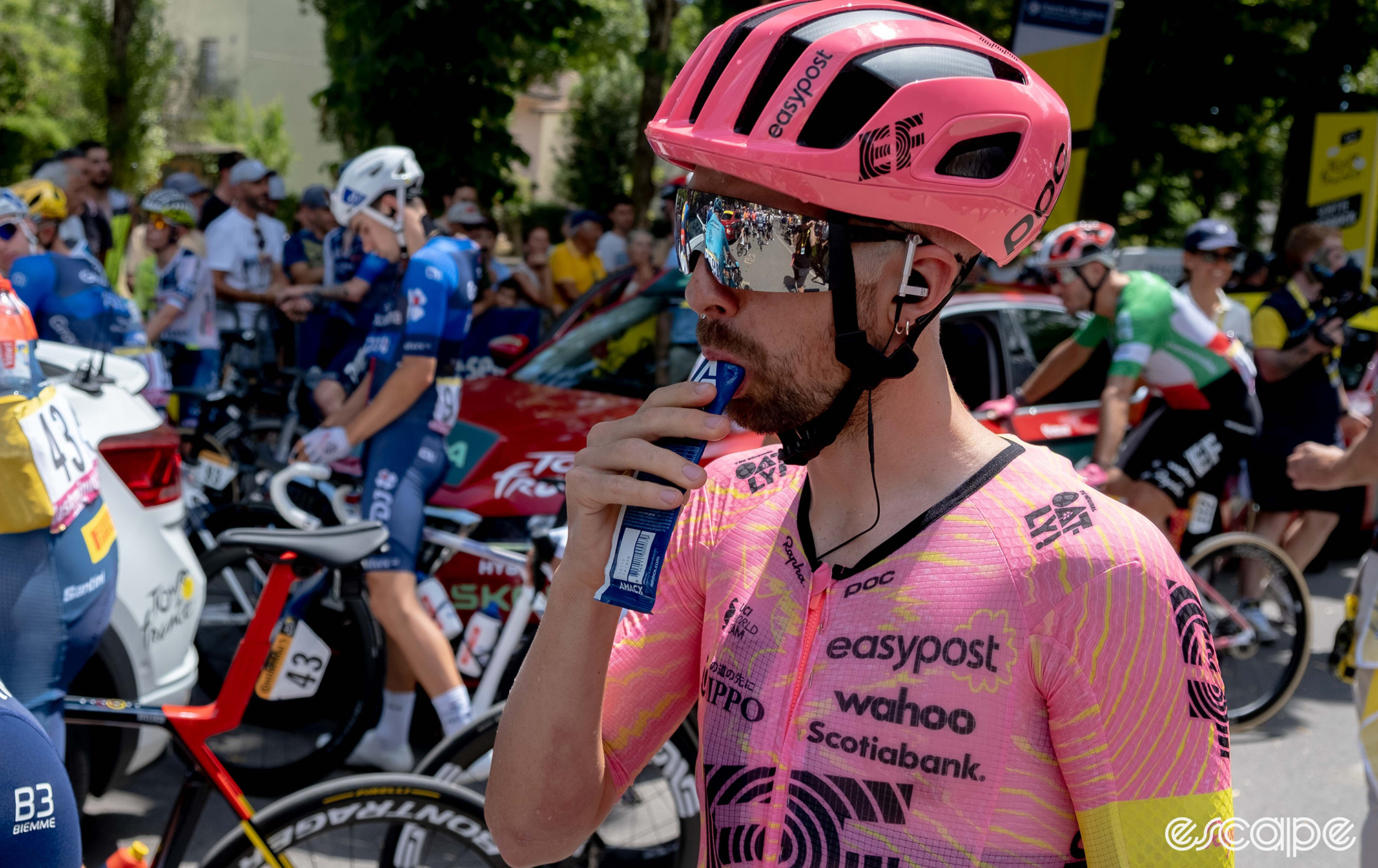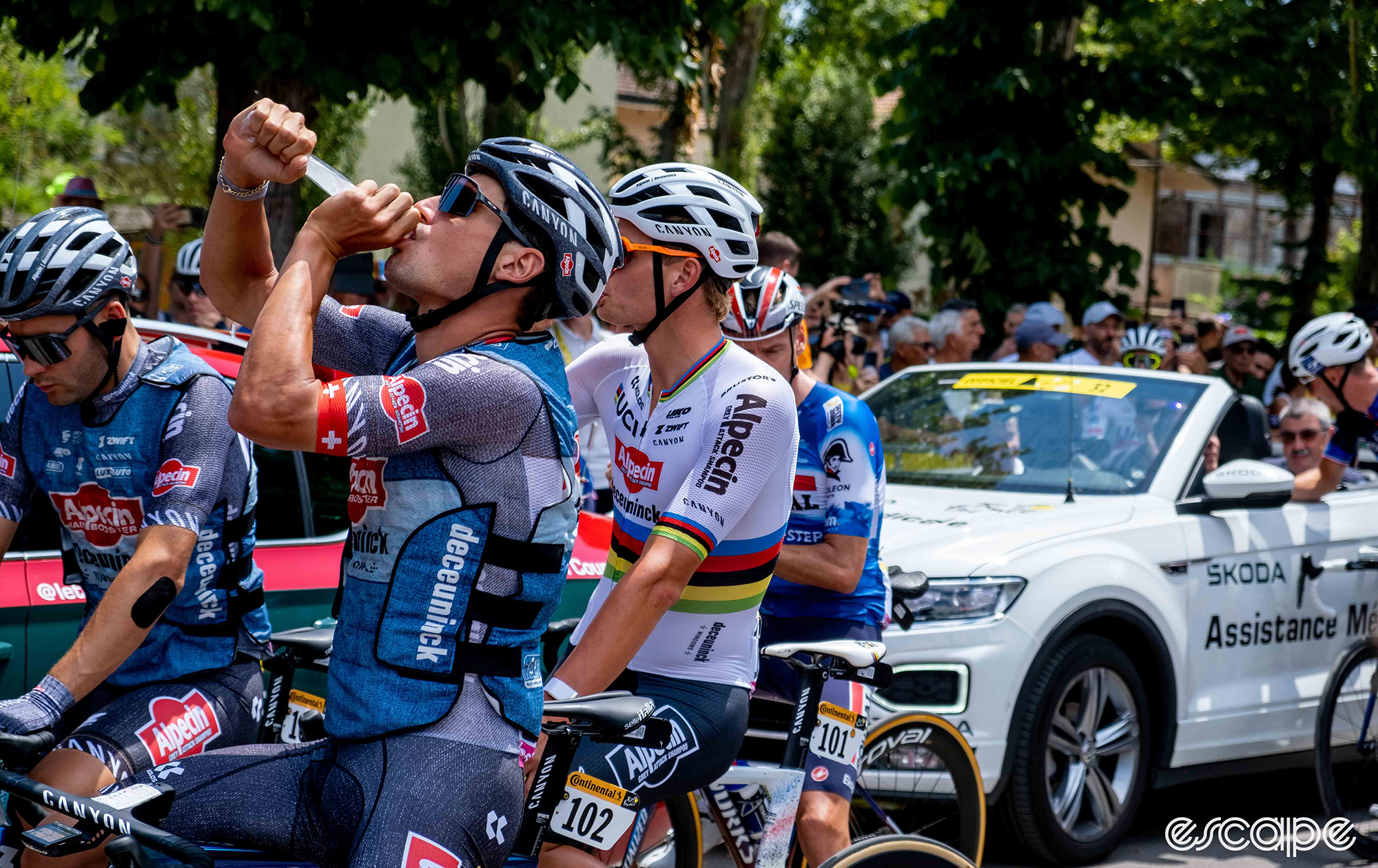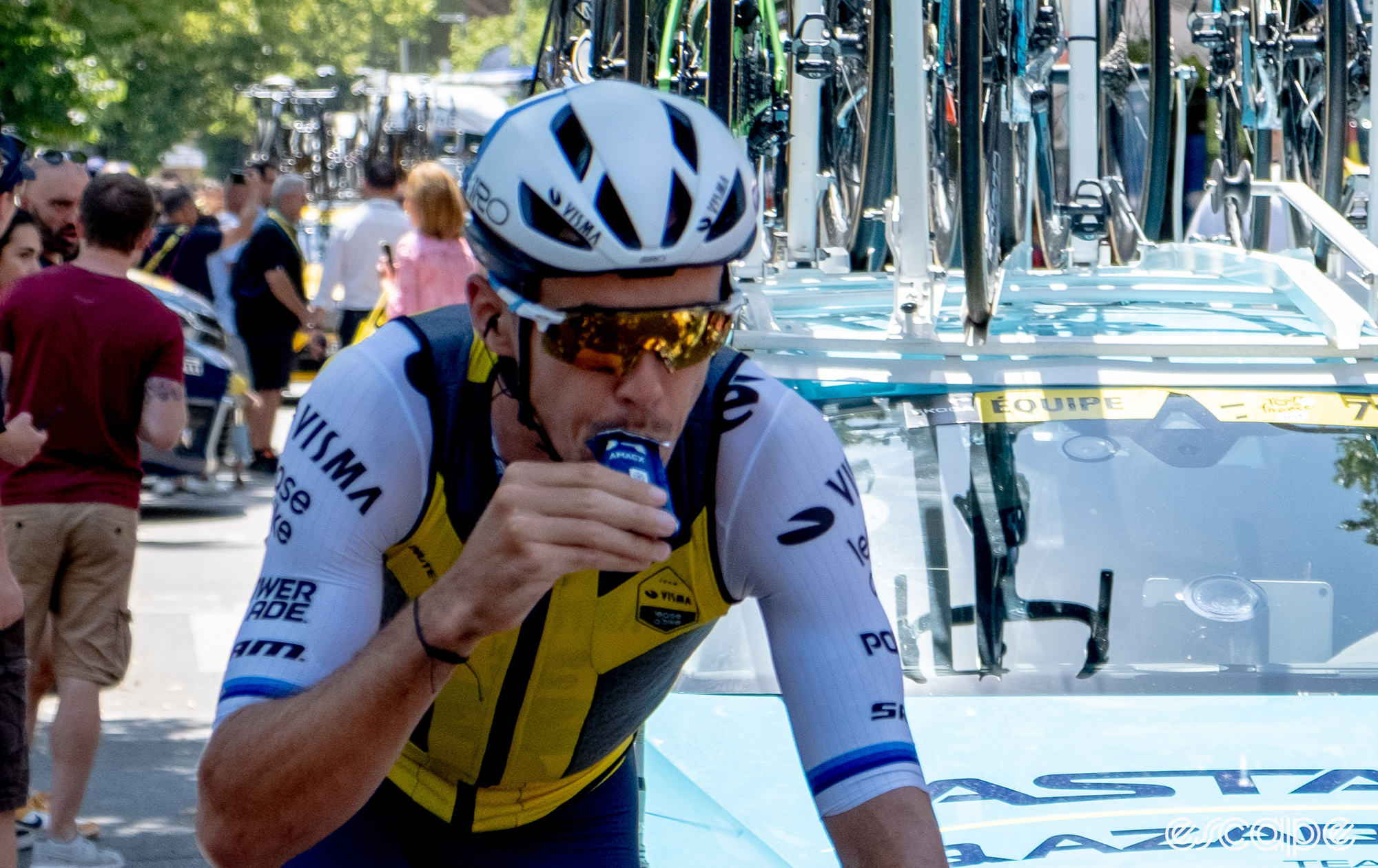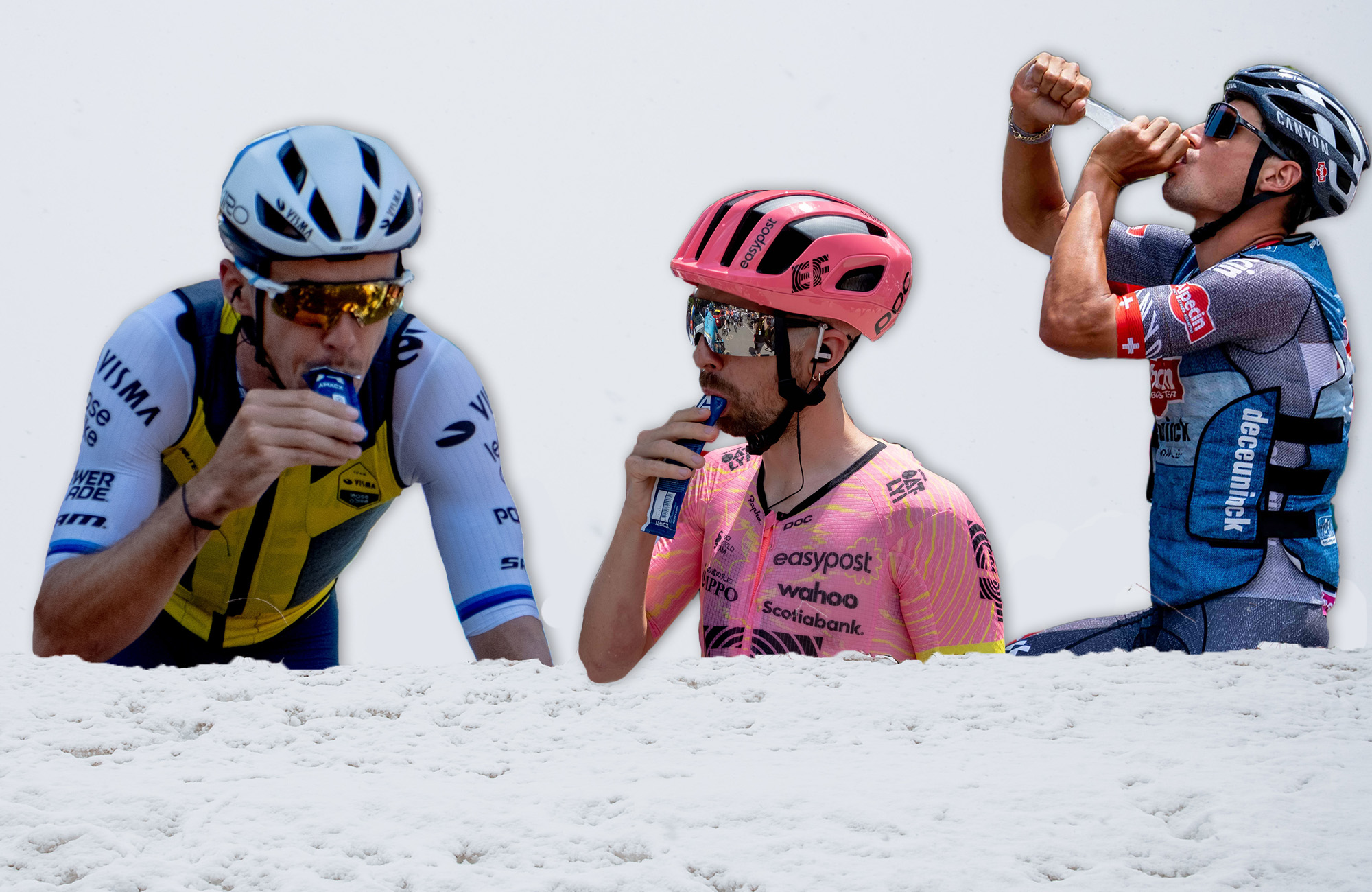Everyone knows that keeping cool is the name of the game at summer bike races, but specifically Big Deal bike races like the Tour de France.
Ronan McLaughlin did a podcast about it, Tour Daily intern Joshua Robinson of the Wall Street Journal wrote a piece about riders drinking slushies in his Big Paper during the heat wave that hit the Tour two years ago.
Last year was hot but comparatively cooler, and this year cooler still, yet European summers are getting warmer and so teams are having to adapt and increase their focus on keeping athletes as cool as possible.
A Grand Départ in Italy this year – farther south than any start would be on French soil – invited boiling hot temperatures in Tuscany and meant teams had to fire up their keep-cool policies from the gun. As we returned after the second rest day and hurtled towards Nîmes, the stinking hot back of the knee of La Belle France, the heat management procedures would be back out in force.
EF Education-EasyPost, like many other teams, have a temperature protocol that takes into account both the actual temperature of the stage and the weather, with factors including whether rain is expected, as well as the expected difficulty of the stage.
"We use stop-light colours," their team doctor David Castol tells me. "Green, yellow and red. Green will be for a cool-ish day, yellow is for moderate days, like the ones we've had in the days before and red. Right now the one we're using is above a certain temperature, it uniformly changes. The difference between each colour ... we use the same products but just cool them down more. We use the slushies or ice to help the riders to cool down their core temperature."
Most intriguingly, as our Ronan Mc Laughlin spotted in Italy during the opening stages, was the use of ice gels at the start of stage 3 in Piacenza. The brand we saw being used was Amacx (we're sure other brands are available).
Sure, ice gels have been around for a while, but as Visma-Lease a Bike would confirm to us, their increased availability commercially as well as other teams spying the more advanced teams using them means they become a more common sight with each passing hot stage.

"The main reason to use them is of course for temperature regulation," Visma-Lease a Bike's performance nutritionist Martijn Redegeld tells us. "We try to keep the riders cool externally, with the ice vests, pouring water over their heads. But the nice things about these ice gels, or slushies, is they cool the body from the inside and it's also a very effective way of keeping the core temperature as low as possible."
So, how long has Visma been using them?
"We have been using them already for three or four years now, we kept on developing it," Redegeld explains. "The ones we have now we didn't have three years ago. But I think you see them more and more often in other teams also because they're now commercially available from multiple brands. But I know some teams just make ice lollies in the freezer. That's how it goes in the peloton, when guys see something happening with their colleagues, they want to get the same thing."
Aha! So the ice gels got rave reviews and your riders' peers got jealous?
"The riders just really like them for the taste. It's like an ice lolly," Redegeld promises. "In reality it's the same composition as a normal gel so they get all of the necessary energy in but just in a tastier way. That's really nice and using these instead of slushies in the race is way more practical. We can sort them easily in the car whereas it's not as easy to put a slushie machine in the car and make slushies and then hand them over to the riders."
While we enjoy the mental image of Grischa Niermann plugging a slushie machine into the cigarette lighter of his car while hurtling along inside the Tour convoy, this is probably not an optimum way to tell Wout van Aert he's a motorbike while keeping one eye on the road ahead.

Redegeld continues to explain that the ice gels are frozen solid (obviously) when taking out of the freezer but begin to melt quite quickly when being carried in a pocket, and that most Visma riders prefer them super cold with a good bite to them.
This means – for EF Education-EasyPost at least but likely is a uniform approach across the peloton – that riders are sent off from the bus in the morning with pockets loaded with regular gels, while ice gels are handed out taped to bidons at feed zones along the day's route after being kept in coolers until the last possible moment before the soigneur stands at the roadside, arm out.
"The palatability is different, also the composition of the ice gel is a bit different," EF's Castol explains, giving us some more in-depth info on ice gels. "It has more electrolytes and it's not as ... I mean since it has to freeze the consistency is different to a normal gel. The flavour is also different so we have more fresh flavours like lemon or mint and the taste is a bit saltier, so after having other fuelling products throughout the day this helps also. Cooling down, a normal gel doesn't do the same job and the taste is different. They like that, we also use ice slushies at the beginning of a really hot stage and at the end to help them cool down. They start with a thermic water bottle as well which is way cooler than their usual bottle."
These thermic water bottles get returned to the team car early in the stage, as there are not as many of these 750 ml bidons as the regular 500 ml ones that are gladly tossed to fans lining the route.
Okay, we know about the gels now, but more broadly how do riders' nutritional needs change on days when it is baking hot?

"Their need for fluids increases dramatically," Redegeld says. "They try to drink two to three bottles per hour, that's the major one. Sodium needs can increase but that's more rider-specific, how much they need to replace. But carbohydrate needs can also increase because the day can just be more demanding, they need more energy to make it to the finish."
And finally, hot race conditions is something you are probably increasingly focused on?
"We see the importance of [heat management] as European summers get hotter and hotter," Redegeld replies. "It increases the need for us to do something and then find advantages compared to the other teams so we really try to focus on it as good as possible to keep the riders cool."
After we thank Redegeld for his time, he kindly asks us if we'd like to try an ice gel for ourselves. We say absolutely, and he retrieves a couple from the team bus.
They are, in the grand scheme of things, much like ice lollies, except chewier, and with a saltier taste. We can see why the riders like them compared to regular gels. A rare treat amongst three weeks of the most exercise a human should appropriately be expected to do.
Safe to say, probably only use them when you are undertaking a large amount of exercise rather than sitting in a car for three hours on the highway.
Did we do a good job with this story?



